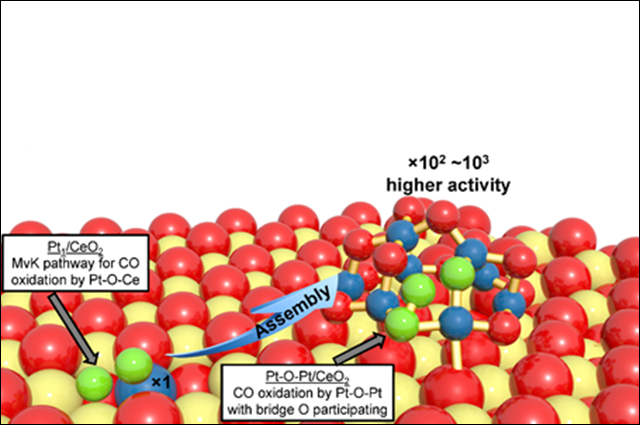Higher catalytic activity achieved

Alumnus Ming Yang, EG16 (now with General Motors Global Research and Development), recent Ph.D. graduate Jilei Liu, EG18, and Distinguished Professor Maria Flytzani-Stephanopoulos, Robert and Marcy Haber Endowed Professor in Energy Sustainability, recently published research in Nature Communications with colleagues from Tianjin University, the University of Michigan – Ann Abor, Oak Ridge National Laboratory, and Argonne National Laboratory.
The researchers’ work indicates that a new group of platinum catalysts can greatly increase activity response in single atom materials operating in low-temperature, oxygen-rich conditions. These catalysts may be appropriate for application in automotive emission controls within cold engine and cold weather environments.
Single atom catalysts — materials in which the catalytically active metal species exist as isolated atoms stabilized by another metal or various catalyst supports — have garnered attention in recent years due to their complete atom efficiency and their ability to reduce the usage of expensive metals. However, it is not yet clear if these catalysts yield the optimal response in reactions common to diesel, lean-burn gasoline, and hybrid vehicles emissions control.
Working with platinum (Pt) and oxygen (O) atoms, the researchers demonstrated that pairing a single atom catalyst made of Pt as a one-layer multi-atom Pt-O-Pt site can be 1,000 times more active than a single atom catalyst alone, for low-temperature CO oxidation near ambient temperatures. The researchers found that this pairing generates increased activity due to the Pt-O-Pt ensemble’s ability to easily activate oxygen within the catalyst (see Fig. 1). Their findings could be implemented within the latest fuel-efficient engines designed to reduce vehicle exhaust emissions. For certain reactions, single atom catalysts can therefore be exploited as parent material platforms to generate even higher activities, while retaining the complete atom efficiency of the expensive metals.
The researchers plan to extend their design to other reaction systems in future work. Read the full paper, “Surpassing the single-atom catalytic activity limit through paired Pt-O-Pt ensemble built from isolated Pt1 atoms,” in Nature Communications.
Department:
Chemical and Biological Engineering